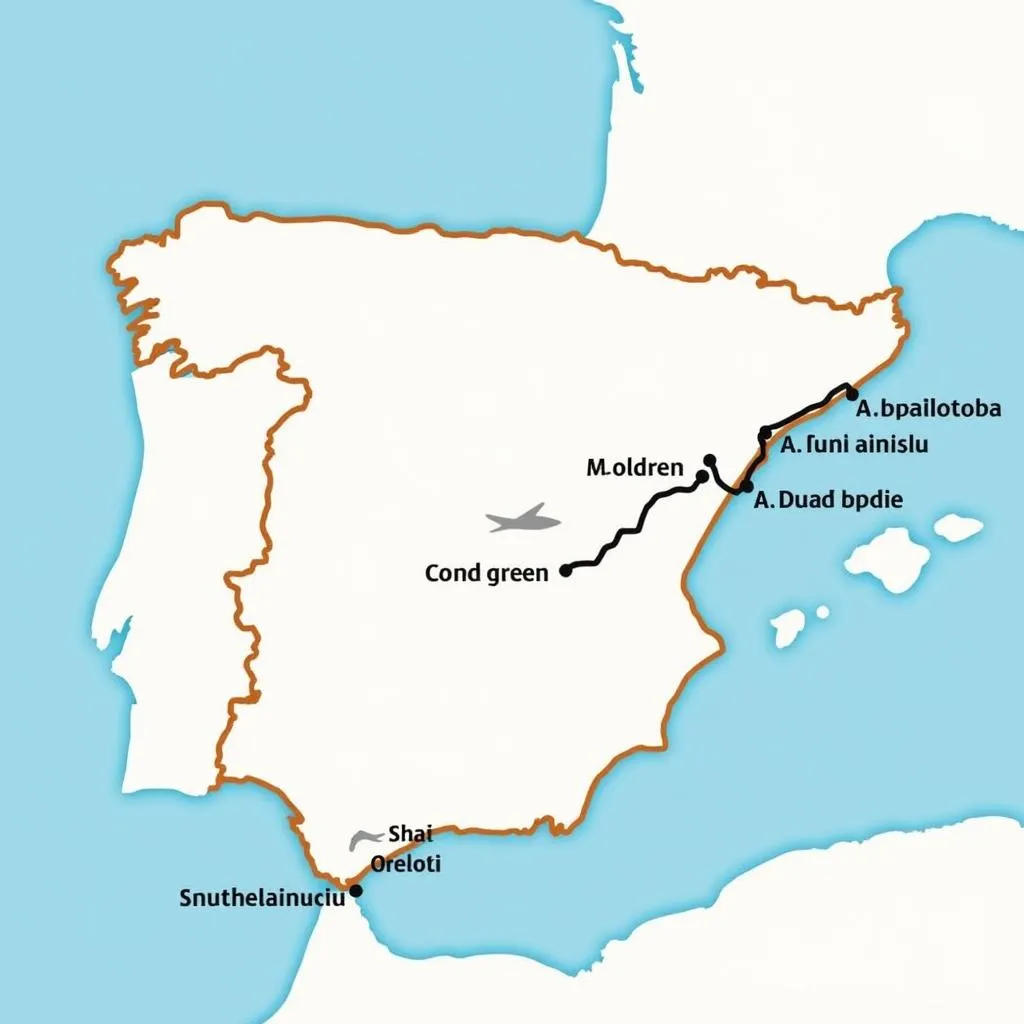Navigating the skies of Spain begins with understanding the language of airports – airport codes. These three-letter combinations are your passport to vibrant cities, sun-drenched beaches, and cultural wonders. Whether you’re dreaming of tapas in Barcelona or flamenco in Seville, knowing the right Spain Airport Code is your first step towards an unforgettable journey.
Decoding the Mystery of Airport Codes
Each airport code, also known as an IATA code, tells a story. These codes are standardized by the International Air Transport Association (IATA) and serve as unique identifiers for airports worldwide. In Spain, airport codes are like mini puzzles, often hinting at the city or region they serve.
For example, the code “MAD” instantly transports you to the heart of Spain, Madrid. Similarly, “BCN” conjures up images of Gaudi’s architectural masterpieces in Barcelona. However, some codes require a bit more deciphering. Take “AGP” for instance. This code represents Malaga Airport, the gateway to the Costa del Sol.
 Malaga Airport Costa del Sol
Malaga Airport Costa del Sol
Unveiling the Importance of Spain Airport Codes
Imagine you’re booking your dream trip to Spain. You’ve found the perfect flight deal, but there’s a catch – multiple airports serve the region you want to visit. This is where understanding Spain airport codes becomes crucial.
Choosing the wrong airport could mean landing hours away from your final destination, adding unnecessary travel time and expenses to your itinerary. For example, if you’re heading to the Bilbao airport, you wouldn’t want to mistakenly book a flight to Biarritz Airport in France, despite its proximity to the Spanish border.
 Map of Spain with Airports
Map of Spain with Airports
Mastering the Art of Airport Code Deciphering
While some Spain airport codes are straightforward, others require a little detective work. Here are some tips to crack the code:
- Pay attention to the first letter: The first letter often (but not always) corresponds to the region or city the airport serves. For instance, airports in the Canary Islands typically start with the letter “T” (e.g., TFN for Tenerife North Airport).
- Consider common abbreviations: Think about common abbreviations for Spanish cities and regions. For example, “SVQ” represents Seville Airport, using the abbreviation “SVQ” for Sevilla.
- Utilize online resources: When in doubt, numerous online airport code databases and search engines can quickly point you in the right direction. Simply enter the code you’re unsure about, and voila!
Top Spain Airport Codes: Your Gateway to Adventure
Let’s explore some of the most popular Spain airport codes and the destinations they unlock:
- MAD (Madrid Barajas Airport): Your gateway to the nation’s capital, Madrid, a city brimming with art, history, and culinary delights.
- BCN (Barcelona-El Prat Airport): Prepare to be captivated by Barcelona’s architectural wonders, vibrant nightlife, and Mediterranean charm.
- AGP (Malaga-Costa del Sol Airport): Step into the sun-kissed paradise of the Costa del Sol, known for its stunning beaches, golf courses, and Andalusian flair.
- PMI (Palma de Mallorca Airport): Discover the beauty of Mallorca, the largest of the Balearic Islands, with its turquoise waters, picturesque villages, and dramatic mountains.
- TFN (Tenerife North Airport) and TFS (Tenerife South Airport): Explore the volcanic landscapes, lush forests, and stunning beaches of Tenerife, the largest of the Canary Islands.
 Tenerife Airport Canary Islands
Tenerife Airport Canary Islands
Beyond the Code: Essential Tips for Smooth Airport Navigation
- Double-check your itinerary: Always confirm you have the correct airport code (and terminal, if applicable) on your flight tickets.
- Allow ample time for connections: Especially when flying between different airports serving the same city (e.g., Madrid or Tenerife).
- Familiarize yourself with airport layouts: Many airports offer online maps and information to help you navigate terminals and locate gates.
- Consider transportation options: Research transportation choices from the airport to your final destination, whether it’s by taxi, bus, train, or rental car.
“Understanding Spain airport codes is like having a secret language that unlocks the country’s treasures. It empowers travelers to navigate with confidence and make the most of their Spanish adventure.” – Javier Lopez, Travel Blogger & Spain Enthusiast
Spain Airport Codes: Your FAQs Answered
1. What does the “UP” in airport codes signify?
While not specific to Spain, the code “UP” often appears in airport names listed alphabetically online (e.g., on the UP Airport Name List) and doesn’t represent a specific airport.
2. How can I find a specific Spain airport code?
Numerous online resources, including IATA’s website and general search engines, allow you to search for airport codes by city, region, or country.
3. Do all Spanish airports have three-letter codes?
Yes, all airports recognized by the IATA have a unique three-letter code for easy identification and international standardization.
Ready to Embark on Your Spanish Journey?
Spain awaits, with its diverse landscapes, vibrant culture, and welcoming spirit. By deciphering the language of Spain airport codes, you’re one step closer to unlocking unforgettable experiences. So, start planning your itinerary, book your flights, and get ready to create memories that will last a lifetime.
Need assistance with your travel plans? Contact our 24/7 customer support team at +13089626264, email us at [email protected], or visit us at 404 Bothwell St, Oxford, NE 68967, USA. Your Spanish adventure starts now!

